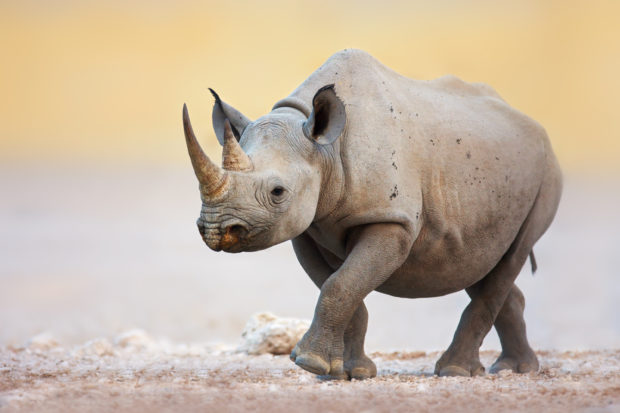
Black rhinos are critically endangered, with fewer than 5,500 left in the wild. But for trophy hunters, the rarer the animal, the more valuable the trophy is, and the greater the prestige and thrill of killing it. Photo by iStockphoto
The other day, the Washington Post’s Pam Constable published a story about a wealthy American hunter who paid $110,000 for the right to kill a rare and magnificent mountain goat in Pakistan. There are just several thousand markhors alive, so it’s hard to see how killing one does the species much good. But that’s the warped and self-serving rationale of the trophy hunter, and the government agencies here and abroad who make his mischief possible.
We’re taking on such Orwellian logic and its terrible consequences very directly. On the heels of our January undercover investigation that revealed numerous wildlife products being offered for sale in violation of state law at the annual Safari Club International convention in Reno, we are opposing a permit the U.S. Fish and Wildlife Service is poised to give to another American trophy hunter who wants to import parts of a Critically Endangered black rhino.
With only about 5,250 black rhinos remaining in the wild, and fewer than 2,000 in Namibia, you would think the species would be off-limits to trophy hunters. But sadly, on the contrary, rareness and endangerment only stokes their desire to add these animals’ parts to their collections.
The FWS opened the flood gates back in 2013 when it issued its first Critically Endangered black rhino trophy import permit in 33 years, to an American hunter who paid $175,000 to slay one of these rare animals in Namibia. The FWS allowed two more black rhino trophies to come into the U.S. in 2015 and permitted another in 2018. On Monday, the FWS announced it has received yet another import permit application from a different American hunter who paid $400,000 to kill a 35-year-old male black rhino in Namibia’s Mangetti National Park in 2017; he wants to import the animal’s two horns, skull, bones, teeth, four feet and full skin as trophies.
This hapless rhino, according to the application, was labeled a “problem causing black rhinoceros bull,” and moved to Mangetti from Etosha National Park in 2009. Now it is claimed he must be killed because he is interfering with breeding by younger bulls. The truth is that, in black rhino society, the older males don’t allow the younger males to breed; this is how nature works to allow these dominant males to pass their superior genes to the next generation. The real reason for authorizing the kill is revealed in the application: he has “outstanding trophies” according to the Namibian Ministry of Environment and Tourism.
The Ministry also claims that the money paid by the hunter will be used for rhino conservation. Since the black rhino is an endangered species under the U.S. Endangered Species Act, the Service can only issue an import permit if the agency finds that killing the animal and importing the trophy will enhance the survival of the species in the wild. Thus, the claims of Namibian officials are alleged to satisfy this criterion.
Of course, killing a Critically Endangered rhino and importing the trophy clearly does not benefit the survival of the species. The truth is that this “pay to slay” scheme is not working and is unlawful. Black rhino poaching has increased in Namibia since 2014; before then zero rhinos were poached each year; but by 2016, the number had increased to 80. This increase demonstrates that the Namibian government is failing to protect black rhinos from criminals. This escalation of poaching occurred despite American trophy hunters having paid over a million dollars to the government of Namibia over the past five years for the right to kill the last of these magnificent animals.
The United States government should not be issuing permits to import black rhinos from Namibia or any other country, not least because this killing does not enhance the survival of the species as required by law.
Please take a moment to leave a respectful comment asking the U.S. Fish and Wildlife Service to deny the permit application to import the trophy of an endangered black rhino—with just over 5,000 black rhinos left, it is time for the agency to step up and protect the species before it’s too late.
The post Fish and Wildlife Service fails in its mission to protect critically endangered species appeared first on A Humane World.
Enviroshop is maintained by dedicated NetSys Interactive Inc. owners & employees who generously contribute their time to maintenance & editing, web design, custom programming, & website hosting for Enviroshop.
